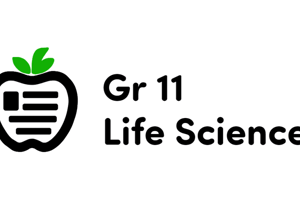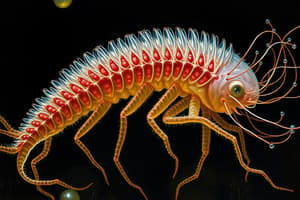Podcast
Questions and Answers
Which group of animal-like protists possess flagella for locomotion?
Which group of animal-like protists possess flagella for locomotion?
- Phytoflagellates (correct)
- Amoebid animal-like protists
- Sporozoans
- Ciliated animal-like protists
Which group of animal-like protists develop pseudopodia for locomotion and engulfing food?
Which group of animal-like protists develop pseudopodia for locomotion and engulfing food?
- Sporozoans
- Phytoflagellates
- Amoebid animal-like protists (correct)
- Ciliated animal-like protists
Which group of animal-like protists is mostly endoparasites and causes diseases like coccidiosis?
Which group of animal-like protists is mostly endoparasites and causes diseases like coccidiosis?
- Sporozoans (correct)
- Ciliated animal-like protists
- Flagellated animal-like protists
- Phytoflagellates
What is the main method of nutrition for sporozoans?
What is the main method of nutrition for sporozoans?
Which group of animal-like protists develop a number of cilia for locomotion?
Which group of animal-like protists develop a number of cilia for locomotion?
In which group of animal-like protists do members possess an oral groove for ingestion?
In which group of animal-like protists do members possess an oral groove for ingestion?
Flashcards are hidden until you start studying
Study Notes
Animal-Like Protists
- All animal-like protists are heterotrophs, except Phytomastigophora, which are autotrophic.
Flagellated Animal-Like Protists (Protozoans)
- Possess flagella for locomotion.
- May be free-living aquatics, parasites, commensals, or symbionts.
- Phytoflagellates are aquatic and live in fresh or marine waters.
- Zooflagellates are generally uninucleated, occasionally multinucleate.
Amoebid Animal-Like Protists (Protozoans)
- Develop pseudopodia (temporary protoplasmic outgrowths) for locomotion and engulfing food articles.
- Sarcodines are mostly free-living (e.g., Amoeba proteus) and found in fresh water, sea water, and on damp soil.
- Some species, like Entamoeba histolytica, are parasitic.
Sporozoans
- All sporozoans are endoparasites.
- Some sporozoans, such as Eimeria sp., cause severe diseases like coccidiosis in birds.
- Nutrition is parasitic (absorptive), and phagotrophy is rare.
Ciliated Animal-Like Protists (Protozoans)
- Ciliates develop a number of cilia during a part or whole of the life cycle.
- Use cilia for locomotion and driving food.
- Show a high degree of morphological and physiological specialization.
- Have definite regions for ingestion and egestion.
- The region of ingestion consists of an oral groove.
Studying That Suits You
Use AI to generate personalized quizzes and flashcards to suit your learning preferences.




